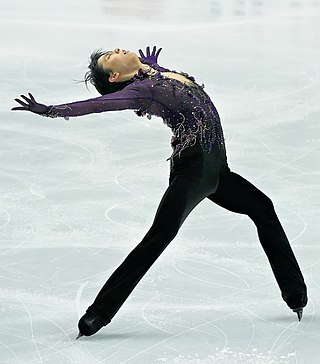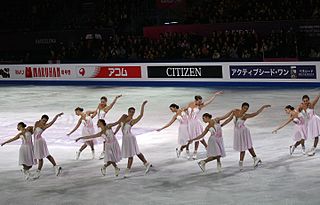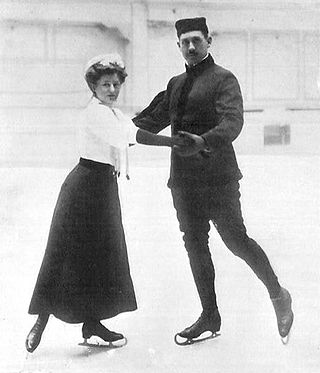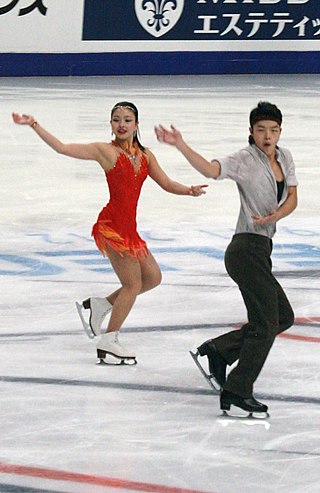Gallery
- Maia Shibutani and Alex Shibutani, 2012
- Meryl Davis and Charlie White, 2009
- Tessa Virtue and Scott Moir, 2011
- Kristine Musademba, 2008
- Nathalie Pechalat and Fabian Bourzat, 2011
- Alexandra Zaretski and Roman Zaretski , 2009
| Figure skating element | |
|---|---|
| Element name | Twizzle |
| Scoring abbreviation | SyTw in the RD, SeTw in the FD |
A twizzle is "a multirotational, one-foot turn that moves across the ice" [1] in the sport of figure skating. First performed by David Grant in 1990 the International Skating Union (ISU) defines a twizzle as "a traveling turn on one foot with one or more rotations which is quickly rotated with a continuous (uninterrupted) action". [2] It is most often performed in ice dance, although single skaters and pair skaters also perform the element. Twizzles have been called "the quads of ice dance" [1] because like quadruple jumps in other disciplines, twizzles are risky and technically demanding.
A twizzle is "a multirotational, one-foot turn that moves across the ice" [1] in the sport of figure skating. It is a "a difficult turn" [3] in single skating. The International Skating Union (ISU), the governing body of figure skating, defines a twizzle as "a traveling turn on one foot with one or more rotations which is quickly rotated with a continuous (uninterrupted) action". [2] A spin, by comparison, is a stationary, multi-rotational turn. Twizzle sequences, when executed well, are often the highlight of ice dance programs. [1] A set of synchronized twizzles is a series of two twizzles for each partner, with up to four steps between twizzles. A set of sequential twizzles is a series of two twizzles for each partner, with up to one step between twizzles. For both a set of synchronized twizzles and a set of sequential twizzles, each twizzle should be at least one full rotation on one foot performed at the same time by both partners. [4] American ice dancer Alex Shibutani calls twizzles "the quads of ice dance" [1] because like quadruple jumps in other disciplines, twizzles, which appear most often in ice dance programs, are risky and technically demanding. [1]
There are four types of entry edges for twizzles: the forward inside, the forward outside, the backward inside, and the backward outside. A twizzle-like motion is a motion in which the skating foot executes less than a full turn, followed by a step forward, while the body performs one full continuous motion. [4] A series of three-turn steps do not constitute a twizzle because they do not constitute a continuous action. If the skater stops traveling during the action, it is deemed a solo spin (or pirouette) and not counted as a twizzle. [2]
Twizzles, like steps, must be executed on clean edges. [3] In a twizzle, the skater's weight is on the skating foot, with the free foot in any position during the turn, and then placed beside the skating foot to skate the next step. [2] Although the twizzle is not considered a difficult move compared to other elements in figure skating, when a twizzle is executed properly the three turns are done so quickly that it is difficult to see the turns. The skater must continually rotate and move across the ice on one foot, by executing a quickly-controlled rocking action on their blade. Skaters must have equal strength in each rotational direction while having exact synchronicity with their partners. They increase the difficulty of twizzles, and earn more points for them, by performing variations in the placements of the leg (grabbing the blade while extending the leg) and arms (moving the arm or arms over the head or behind the back). According to American ice dancer Colin McManus, the finesse required in mastering the twizzle makes it "very easy to run into issues like putting your foot down or hitting your toe pick". [1] According to Shibutani, high-quality twizzles are performed when skaters focus on gathering speed entering a twizzle sequence, which provides enough directional force to continue rotating as long as the choreography demands, and that muscle memory should carry them through the rest of the sequence. Shibutani reported that strong teams are able to adjust, make self-corrections, and follow what their partners are doing. [1] He also said that there is "no room for mental errors at all". [1]
When ice dancers perform twizzles too slowly, trip while traveling across the ice, or fall out of sync with each other, it can ruin the flow of a program and "deflate the energy in the arena". [1] According to Shibutani, practice, relying on muscle memory, and a good partnership are the keys to performing successful twizzle sequences. He said, about he and his long-time partner and sibling Maia Shibutani, "Hopefully, we’re rotating so fast that we can’t really see each other and it’s just kind of a feel thing". [1] American ice dancer Meryl Davis reported, when speaking about how detailed and exact the synchronization is in the execution of twizzles, that she and her partner Charlie White knew the placement of each other's feet based on the sounds their blades made on the ice. Maia Shibutani stated that partners need to have strong individual skating skills and that staying in the moment is important because when skaters lose focus and think too far ahead, "then you're finished". [1]

Figure skating is a sport in which individuals, pairs, or groups perform on figure skates on ice. It was the first winter sport to be included in the Olympic Games, with its introduction occurring at the 1908 Olympics in London. The Olympic disciplines are men's singles, women's singles, pair skating, and ice dance; the four individual disciplines are also combined into a team event, which was first included in the Winter Olympics in 2014. The non-Olympic disciplines include synchronized skating, Theater on Ice, and four skating. From intermediate through senior-level competition, skaters generally perform two programs, which, depending on the discipline, may include spins, jumps, moves in the field, lifts, throw jumps, death spirals, and other elements or moves.

Ice dance is a discipline of figure skating that historically draws from ballroom dancing. It joined the World Figure Skating Championships in 1952, and became a Winter Olympic Games medal sport in 1976. According to the International Skating Union (ISU), the governing body of figure skating, an ice dance team consists of one woman and one man.
Figure skating jumps are an element of three competitive figure skating disciplines: men's singles, women's singles, and pair skating – but not ice dancing. Jumping in figure skating is "relatively recent". They were originally individual compulsory figures, and sometimes special figures; many jumps were named after the skaters who invented them or from the figures from which they were developed. It was not until the early part of the 20th century, well after the establishment of organized skating competitions, when jumps with the potential of being completed with multiple revolutions were invented and when jumps were formally categorized. In the 1920s Austrian skaters began to perform the first double jumps in practice. Skaters experimented with jumps, and by the end of the period, the modern repertoire of jumps had been developed. Jumps did not have a major role in free skating programs during international competitions until the 1930s. During the post-war period and into the 1950s and early 1960s, triple jumps became more common for both male and female skaters, and a full repertoire of two-revolution jumps had been fully developed. In the 1980s men were expected to complete four or five difficult triple jumps, and women had to perform the easier triples. By the 1990s, after compulsory figures were removed from competitions, multi-revolution jumps became more important in figure skating.

Spins are an element in figure skating in which the skater rotates, centered on a single point on the ice, while holding one or more body positions. They are performed by all disciplines of the sport, single skating, pair skating, and ice dance, and are a required element in most figure skating competitions. As The New York Times says, "While jumps look like sport, spins look more like art. While jumps provide the suspense, spins provide the scenery, but there is so much more to the scenery than most viewers have time or means to grasp". According to world champion and figure skating commentator Scott Hamilton, spins are often used "as breathing points or transitions to bigger things".

Synchronized skating, often called synchro, is an ice skating sport where between 8 and 20 skaters perform together as a team. They move as a flowing unit at high speed over the ice, while performing elements and footwork.
Artistic roller skating is a competitive sport similar to figure skating but where competitors wear roller skates instead of ice skates. Within artistic roller skating, there are several disciplines:

Pair skating is a figure skating discipline defined by the International Skating Union (ISU) as "the skating of two persons in unison who perform their movements in such harmony with each other as to give the impression of genuine Pair Skating as compared with independent Single Skating". The ISU also states that a pairs team consists of "one Woman and one Man". Pair skating, along with men's and women's single skating, has been an Olympic discipline since figure skating, the oldest Winter Olympic sport, was introduced at the 1908 Summer Olympics in London. The ISU World Figure Skating Championships introduced pair skating in 1908.
The following is a glossary of figure skating terms, sorted alphabetically.
The short program of figure skating is the first of two segments of competitions, skated before the free skating program. It lasts, for both senior and junior singles and pair skaters, 2 minutes and 40 seconds. In synchronized skating, for both juniors and seniors, the short program lasts 2 minutes and 50 seconds. Vocal music with lyrics is allowed for all disciplines since the 2014-2015 season. The short program for single skaters and for pair skaters consists of seven required elements, and there are six required elements for synchronized skaters.
The free skating segment of figure skating, also called the free skate and the long program, is the second of two segments of competitions, skated after the short program. Its duration, across all disciplines, is four minutes for senior skaters and teams, and three and one-half minutes for junior skaters and teams. Vocal music with lyrics is allowed for all disciplines since the 2014—2015 season. The free skating program, across all disciplines, must be well-balanced and include certain elements described and published by the International Skating Union (ISU).

Figure skating lifts are required elements in two disciplines of figure skating: pair skating and ice dance. There are five groups of lifts in pair skating, categorized in order of increasing level of difficulty. Judges look for the following when evaluating pair lifts: speed of entry and exit; control of the woman's free leg when she is exiting out of the lift, with the goal of keeping the leg high and sweeping; the position of the woman in the air; the man's footwork; quick and easy changes of position; and the maintenance of flow throughout the lift. Twist lifts are "the most thrilling and exciting component in pair skating". They can also be the most difficult movement to perform correctly. They require more strength and coordination than many other pair elements, and are usually the first or second element in a program. According to the International Skating Union (ISU), "the Woman must be caught in the air at the waist by the Man prior to landing and be assisted to a smooth landing on the ice on a backward outside edge on one foot" during a twist lift. A pair lift and twist lift is required in the short program of pair skating; a well-balanced free skating program in pair skating must include lifts.

The original dance (OD) was one of the programs performed by figure skaters in ice dance competitions, in which the ice dancers skated "a dance of their own creation to dance music they have selected for the designated rhythm(s)". It was normally the second of three programs in the competition, sandwiched between the compulsory dance (CD) and the free dance (FD). The rhythm(s) and type of music required for the OD changed every season, and were selected by the International Skating Union (ISU) before the start of the season. The ice dancers were free to choose their own music and choreography and to create their own routines. They were judged on a set of required criteria, including skating skills and how well they interpreted the music and the rhythm.
British Ice Skating is the national governing body of ice skating within the United Kingdom. Formed in 1879, it is responsible for overseeing all disciplines of ice skating: figure skating ; synchronised skating; and speed skating.

Maia Harumi Shibutani is an American ice dancer. Partnered with her brother Alex Shibutani, she is a two time 2018 Olympic bronze medalist, a three-time World medalist, the 2016 Four Continents champion, and a two-time U.S. national champion. The siblings have won six titles on the Grand Prix series and stood on the podium at 14 consecutive U.S. Championships, at five levels including eight as seniors. They are two-time members of the US Olympic team, competing at the 2014 and 2018 Winter Olympics. In 2018, the siblings became the first ice dancers who are both of Asian descent to medal at the Olympics. They are the second sibling duo to ever share an ice dancing Olympic medal, and the first from the United States. The Shibutani siblings are often referred to by their nickname the Shib Sibs.
A step sequence is a required element in all four disciplines of figure skating, men's single skating, women's single skating, pair skating, and ice dance. Step sequences have been defined as "steps and turns in a pattern on the ice". Skaters earn the most points in step sequences by performing steps and movements with "flair and personality", by turning in both directions, by using one foot and then the other, and by including up and down movements.

The 2013 Four Continents Figure Skating Championships was a senior international figure skating competition in the 2012–13 season. It was held at the Osaka Municipal Central Gymnasium in Osaka, Japan on February 6–11. Medals were awarded in the disciplines of men's singles, ladies' singles, pair skating, and ice dancing.

The ice dance competition of the 2018 Winter Olympics was held on 19 and 20 February 2018 at the Gangneung Ice Arena in Gangneung, South Korea. The short dance was held on 19 February and the free dance was held on 20 February.

Ice dance, a discipline of figure skating, has required elements that make up a well-balanced rhythm dance program and free dance program, which must be performed during competitions. They include: the dance lift, the dance spin, the step sequence, turn sequences, and choreographic elements. The elements must be performed in specific ways, as described by published communications by the International Skating Union (ISU), unless otherwise specified. The ISU has also provided a list of illegal movements.
The rhythm dance (RD) is the first segment of an ice dance competition. The International Skating Union (ISU) renamed the short dance to the "rhythm dance" in June 2018, prior to the 2018–2019 season. It became part of international competitions in July 2018. French ice dancers Gabriella Papadakis and Guillaume Cizeron hold the highest RD score of 90.83 points, which they achieved at the 2022 Beijing Winter Olympics.
A choreographic sequence is a required element for figure skating in all international competitions. It is required in the free skating programs of senior and junior single skaters and in the free skating programs of senior pair skaters. It is also required during ice dancers' rhythm dances and free dances. Judges do not evaluate individual elements in a choreographic sequence; rather, they note that it was accomplished. Skaters must fulfill certain requirements to fulfill the highest points possible during choreographic sequences. There are six types of choreographic elements in ice dance: the Choreographic lift, the Choreographic spinning movement, the Choreographic assisted jump movement, the Choreographic twizzling movement, the Choreographic sliding movement, and the Choreographic character step sequence.
Tessa Virtue and Scott Moir performing the twizzle during their free dance at the 2018 Olympics.